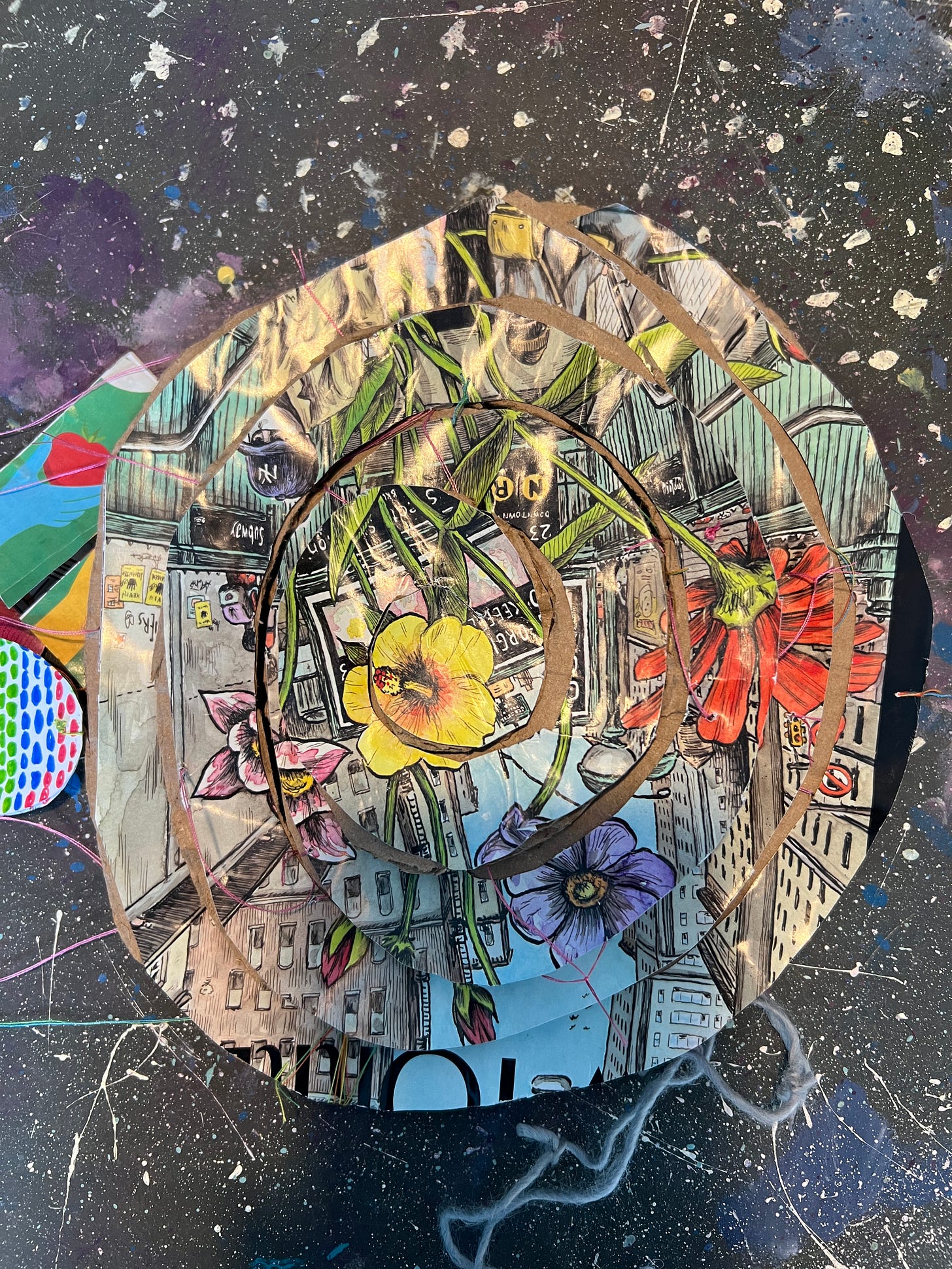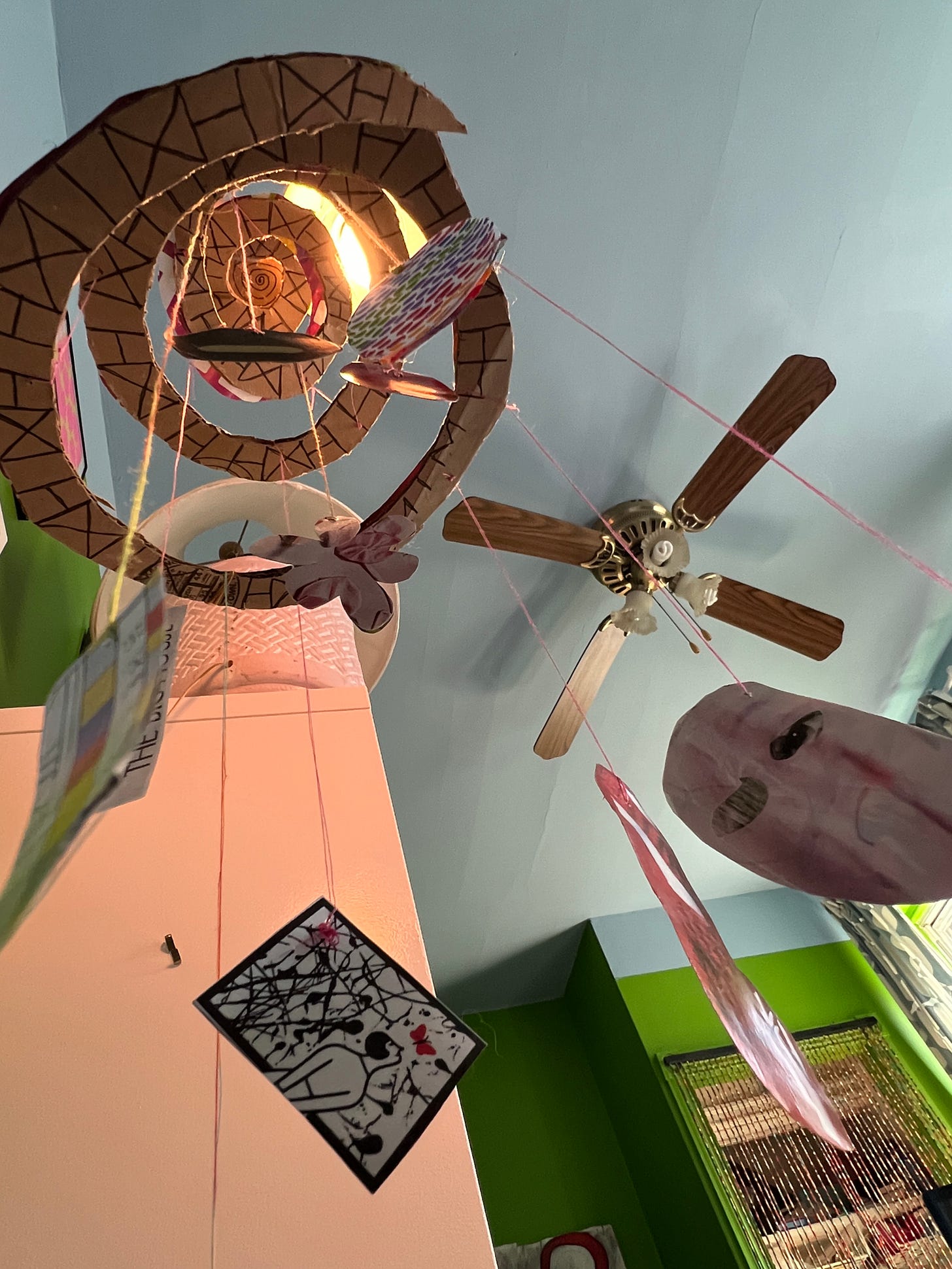We’re offering a FREE 1 hour taster session of our upcoming course, Neuroqueering Your Creative Practice, plus a 15% discount code to anyone who registers. Details at the bottom of this post.
Creative Care with Queer Little Creatures
“It's very gross,” says my friend Meg, who recently launched a substack called Queer Little Creatures, “but I often say I just feel emotionally constipated. Like I don't know what I'm feeling. I cannot get it out. I can't cry. It's just stuck and it feels awful. And so I've sort of developed my own ways of trying to move that through.”
During a difficult five years during which Meg lost both her parents, hit a hard patch in her relationship, moved house, and was diagnosed as neurodivergent, she turned to the practice of what she calls “creative care” to help her work through these experiences and learn to sit with discomfort and slowness. Alexithymia still made it difficult to name and understand her emotions, but she had come to understand—in particular because she is responsible for the care and feeding of a young human—that “not dealing with them just wasn't an option.” A writer by trade, Meg never called herself an artist, though she had been collecting weird bits and bobs—feathers, rocks, abandoned bird nests, even trash—and making art out of it for most of her life. But through what she now recognizes as burnout, she was increasingly aware that words weren’t always serving her, precisely because she cared so much about writing well. She came to understand that she had far greater access to her emotions and experiences through art, “partly because I don't know what I'm doing—there was a permission and a looseness to it that I cannot access in my writing. You don't have to find words with art making, right?”
Often something that ought to be simple and obvious just isn’t, until someone gives it a name and offers an invitation. This is, I think, the experience so many of you have had when I first named and explained my notion of Spiral Time, and especially the metaphor of time as an elliptical orbit, where part of the orbit is all about being super fast and “getting shit done,” but even more of the orbit necessarily consists of “spinning out in space gathering stardust.” The reason this metaphor resonates so deeply and has taken off is because it describes what neurodivergent people already feel and know intuitively, but didn’t have language and imagery for.
This has been my experience of discovering the power of Meg’s invitations to creative care practice. Over the past six weeks, Meg and I have been co-teaching a course called Coming Home to Ourselves, and I was blown away by the power of the creative care practices Meg offered throughout the course. Obviously, I already know the power of creativity and of making—it’s sort of my whole thing, right? And as I have written before in my essay Freak, making art really felt like salvation at a time when words abandoned me. And yet, it has somehow felt groundbreaking the way Meg has framed these creative care practices in the context of our course—the way she has held space and offered generous, thoughtful invitations, and, crucially, the way she has done all that in the midst of, and as a way of fostering, community.
Meg explains that art-making creative care practices “can give us ways of understanding ourselves, of exploring, and when we can pull things in from outside—when we're collaging or focused on texture or colour or shape—it gives us a different way of understanding and expressing whatever it is we're exploring. It doesn't have to come from inside, like words do, if that makes sense, right? I think sometimes with writing, it's like you're trying to say something, and with the creative care practices, instead of trying to say something, I'm seeing what the art says to me.”
This is exactly what happened for me during our Coming Home to Ourselves course. It was such a revelation! In my other workshops and courses, I’ve only ever offered freewriting prompts as a way of processing ideas, emotions, insights, resonances. It has never occurred to me to invite people to make art, and then to transform that art. Even though making and transforming art has been at the heart of my own healing and unmasking journey. So I loved that we were co-teaching the course, because it offered me the opportunity to be on the receiving end of Meg’s invitations within the space she held. It was almost like getting to both teach and take the course. I needed her example to help me remember and put into practice, in community, what I already knew.
One of the things that came up for me was how central my father is to my sense of being a homemaker and of having a home. I’ve been writing about home, homemaking, and my father for decades (remember blogs? and message boards?), but it wasn’t until we made maps of our creative lineage in the Coming Home course that I really put it all together. There are so many ways that I have felt like I failed my father, or fallen short. For example, my father is a master carpenter and cabinet maker. He is an artist, and wood is his medium. He once told me that he regretted not teaching me woodworking when I was a child, and he acknowledged that it was at least in part on account of my being a girl—he had assumed it would be my brother who followed in his footsteps as a craftsman, whereas in retrospect I was clearly the one who had more of that inclination and aptitude. Now he wonders who will want all his woodworking tools when he can no longer use them, because neither my brother nor I has learned his craft.
But the truth is, I’m not sure wood was ever going to be my medium, even if my father had tried to teach me woodworking as a child. I have more of a painterly inclination, and my home has always been less a structure that I build than a canvas on which I make art. But even though our media and skills are quite different, I can trace my creative homemaking lineage directly to my father, as I discovered when Meg invited us to make a map of our creative lineage.
Of course I cut it into a spiral! But when it was flat, it looked like this—a New Yorker cover that depicted a wild garden of flowers emerging from a subway stop on a busy urban street—which kind of sums up my life, as country girl who now lives in the city.
I have recently been looking up images on Google Maps of my childhood home, the House that Jim Built (Jim being my dad), which now looks very much fancier than it did when I was a child, the ugly gray asphalt siding having been replaced by those nice green boards:
But that porch? My dad built that. And even more astonishing to me: the hopscotch he cut into the sidewalk, which he poured over 50 years ago, is still there today!
I wanted to use this image of a hopscotch as the thread that weaves my homemaking creative lineage together, so I drew it on the underside of the spiral:
And then I made a bunch of little icons, or totems, representing various aspects of my own creative life, and especially what I share and have learned from my father (they are very abstract and associative, and mean a lot to me but would probably be lost in the translation if I tried to explain them to you!). I hung them from the spiral to create a sort of mobile. It now hangs from my new lamp, next to my new daybed, surrounded by art made by me and people I love. It makes me inordinately happy, and reminds me of what I always knew on some level, but hadn’t yet fully articulated: that I can directly trace my love and inclination for homemaking back to my father, who like me is an inveterate hermit and homebody.
Meg says offering creative care invitations is “about opening a door for people. You might walk through that door and be like, ‘I made something I love!’ You might walk through that door and be like, ‘This is an empty room and there's nothing for me here.’ You might walk through the door and have a fucking epiphany.
“But once I've opened the door, I don't know what's going to happen. And I'm trying not to open a door and shove people off a cliff, right? I want there to be a floor there, because we're not doing therapy—but I really want people to walk through, to open the door and each be able to find something that's interesting or relevant or beautiful.”
Meg will be offering invitations to creative care in the next iteration of Neuroqueering Your Creative Practice (as well as in the free taster session on 18 March, see below). You can also find Meg at her newly-launched substack, Queer Little Creatures, and you can find her other offerings at her website, Writers in Bloom.
Neuroqueering Your Creative Practice Updates:
KR, Meg and I are co-facilitating a FREE one-hour taster session on Tuesday, March 18th 6-7pm GMT/1-2pm EST/ 10-11am PST. This session will draw from 3 of the 12 course sessions to give you a flavour of what we will cover and how the sessions will generally run. You will get a sense of our three different approaches to facilitating and neuroqueering, and have the opportunity to ask any questions you might have. The session will be recorded and shared with all those who RSVP, so you don't need to be able to attend live in order to engage. Additionally, all those who RSVP to the taster session will receive a 15% discount code to the course!










Great blog! Your creativity, how you write about it, what you do with it, and how you trace it back to your dad (in part, of course there must be other influences) all ties together so well.
Cool beans, Marta! (cool spiral art)